| Image | Plant | Status | Notes | Events |
|---|---|---|---|---|
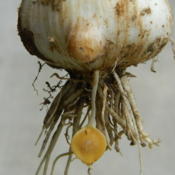 |
Elephant Garlic (Allium ampeloprasum) |
Have 11 Veg Veg Garden |
2023 order Keen Garlic https://keeneorganics.com/prod... |
June 6, 2022: Harvested October 21, 2023: Transplanted |
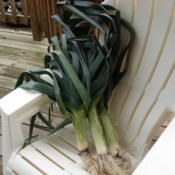 |
Leek (Allium ampeloprasum 'Lancelot') |
Have Veg Garden |
Dixondale Farms https://dixondalefarms.com/pro... |
December 31, 2022: Transplanted May 25, 2023: Harvested |
| Onion (Allium cepa 'Early White Spanish') |
Prev 11 Veg Veg Garden |
November 20, 2021: Transplanted | ||
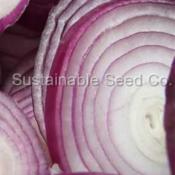 |
Garden Onion (Allium cepa 'Red Creole') |
Prev 11 Veg Veg Garden |
Bulbing started April 1 | November 20, 2021: Transplanted June 6, 2022: Harvested |
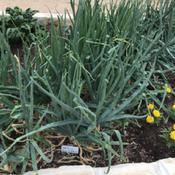 |
Red Onion (Allium cepa 'Rossa di Milano') |
Have Veg Garden |
September 9, 2023: Seeds sown | |
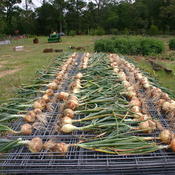 |
Onion (Allium cepa 'Texas Grano 1015Y') |
Prev 11 Veg Veg Garden |
https://dixondalefarms.com/pro... Transplant: Nov Maturity: 115 |
November 20, 2021: Transplanted |
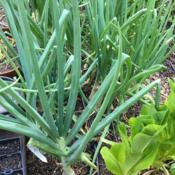 |
Sweet Onion (Allium cepa 'Yellow Granex') |
Have PREFERRED 11 Veg Veg Garden |
ORDER: Oct 15 https://www.dixondalefarms.com... Set: Nov 9 – Apr 11 Maturity: 110 days |
June 13, 2021: Harvested November 20, 2021: Transplanted June 6, 2022: Harvested December 4, 2022: Transplanted May 25, 2023: Harvested March 30, 2024: Transplanted |
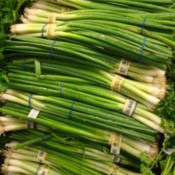 |
Green Onion (Allium fistulosum 'Evergreen Hardy White') |
Have Veg Garden |
September 9, 2023: Seeds sown | |
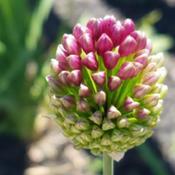 |
Drumsticks (Allium sphaerocephalon) |
Have Fall Bulbs |
blooms in late June Easily grown in most well-drained soils in full sun. Clump forming habit. Prefers consistent moisture during spring and summer, but tolerates dry conditions after blooms fade. Prolific self-seeder if not deadheaded, and will naturalize. Divide clumps and replant in late summer/early fall after foliage fades. Native from Europe to the Caucusus, Iran and north Africa. https://www.tulipworld.com/Fal... https://www.dutchbulbs.com/pro... |
October 18, 2023: Obtained plant January 1, 2024: Seeds sown |
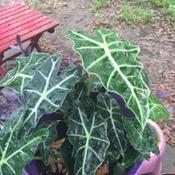 |
African Mask (Alocasia 'Amazonica') |
Prev |
||
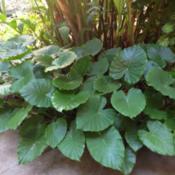 |
Dwarf Elephant Ear (Alocasia gageana) |
Have |
Dormancy: Winter Height: 48" tall Culture: Sun to Light Shade Origin: Burma/Myanmar Root is cold hardy to 7 degrees |
|
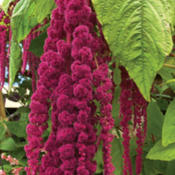 |
Love Lies Bleeding (Amaranthus caudatus) |
Have |
Amaranth is a broad family of plants that were originally used as a grain by ancient people groups of Asia and the Americas. It is easy to grow, easy to harvest, easy to cook, and the seeds are a very good source of protein, thus making it an ideal crop for primitive cultures. There are wild forms of the plant that are commonly known as "Pigweed" and their growth is so vigorous that it creates problems for us in the fields. Amaranth can still be grown as a food source today, but more often it is grown out as a decorative plant. Varieties like "Love Lies Bleeding" has large hanging seed heads that are unique and brightly colored. It can be dried down as well, and arranged with other dried flowers to preserve its unique hanging character. - https://www.everwilde.com/stor... To the Quechua people of South America, Amaranth is referred to as kiwicha, quihuicha, inca jataco; ataco, ataku, sankurachi, jaguarcha (Ecuador), millmi, or coimi. While to the Aymara people, who are native to the Andes and Altiplano regions of South America, Amaranth is known as qamasa. Many parts of the plant, including the leaves and seeds, are edible, and are frequently used as a source of food in India as well as in South America, where it is the most important Andean species of Amaranthus, known as kiwicha. (See also amaranth seed and Andean ancient plants.) This species, as with many other amaranths, is originally from the American tropics. The exact origin is unknown, as Amaranth caudatus is believed to be a wild Amaranthus hybridus aggregate. In indigenous agriculture, A. cruentus is the Central American counterpart to South American A. caudatus. The panicles grow from lateral buds and from the main stem. Amaranth is an annual, broad-leaved dicotyledon with a central stem that grows from a taproot system. Depending on the variety, Amaranth caudatus can reach up to 2.5 m tall. Leaves and side branches grow outward from the central stem and may start as low as the base of the plant. [2] Etymology During the Victorian era, specific flowers had different meanings. Love-lies-bleeding stood for hopeless love or hopelessness in the Victorian language of flowers. History A. caudatus is originally from Central and South America and was used as a staple grain by the Inca, Maya and Aztec civilizations. Because of its high nutritional value, it was culturally considered as a beneficial food for children and elderly. Amaranth caudatus was very important for Aztec people. They believed that kiwicha had the power to give strength to people that eat it. This food was not only used for royalty diet but also in religious rituals. A. caudatus was mixed with honey and human blood and eaten during ceremonies, including human sacrifices. For these reasons, around the 1500s when the conquistadores came, they prohibited the use of the plant and was almost completely banned from these regions. Around the 1800s, A. caudatus slowly started to be cultivated again. Because of its late reuse, due to its history, A. caudatus cultivation is still very localized in America. However, the interest in the cultivation of A. caudatus outside the Andes is increasing again. Natural distribution A. caudatus is an indigenous crop from the high Peruvian Andes that has been cultivated for thousands of years by many cultures including the Incas. It is the only Amaranth species that can grow at altitudes greater than 2,500 meters above the sea level. Despite the fact that A. caudatus had been a well-adapted staple in the Andean region for millennia and had offered substantial nutritional advantages to the native people, when the Spanish came in the 1500s, they replaced A. caudatus cultivations with wheat and barley. However, because of its great nutritional content, A. caudatus is regaining popularity and returning to compete with modern crops. Although A. caudatus is seldom recognized outside of the Andes, significant plantings have been observed in Mexico, China, Nepal, India and Kenya. In most parts of its habitat, A. caudatus can easily grow between 1 and 2.5 meters and grows best in full sun within 4-6 months. However, in some highland regions they can take up to 10 months. It is a summer annual C4 plant. A. caudatus grows from Ecuador to northern Argentina mostly in mild areas or in the valleys of the Andes. Despite its geographical adaptability, it is a short-day plant and needs adequate moisture. Cultivation can occur at up to 3100 m. a.s.l. and once established it is drought tolerant and can handle both wet and dry conditions. If the cultivation takes place in subtropical climates, it can be harvested up to two times. Loam and loam-sandy soils with lots of organic matter and good drainage are best. Clay soils are not recommended for A. caudatus. In addition, the pH must be between 6-7, although the plant can still grow at a pH of up to 8.5. In the Andes of Peru, Bolivia, Ecuador and Argentina, the plant is grown in the traditional way on non-irrigated land without fertilizers. The seeds are very small, so soil preparation is important, such as breaking up of clods and shaking up. It is recommended to plough the soil, harrow and make furrows either in the traditional way with a yoke or by machine. Nutrition The flavourful and gluten-free A. caudatus is very high in protein and essential amino acids, such as lysine, which are typically deficient in plant protein. In terms of nutritional content, A. caudatus protein is virtually similar to milk protein (casein), and it complements the nutritional quality of foods derived from flours of corn, rice, or wheat.[7] As a result, A. caudatus is particularly beneficial for infants, children, and pregnant and lactating women, but also vegetarians and vegans. A. caudatus is high in dietary fiber and minerals such as iron, magnesium and manganese. Its frequent consumption could help to reduce hypertension and cholesterol. A. caudatus has also been found to have anthelmintic, antinociceptive, antipyretic, anticancer, antiallergenic, antidiabetic, immune system stimulation, cardioprotective, hepatoprotective, and antibacterial properties. Culinary use and dishes There are several uses of kiwicha. When ground, it can be used as flour but also as breading for sweets and main dishes when crushed. Seeds can be popped as popcorn on a pan and, like oats, can be eaten with milk as cereals. In Mexico, A. caudatus is used on sweets with honey and the dish is called "alegria" (meaning "happiness" in Spanish), India has a similar dish called "ladoos". A. caudatus is slowly making its way outside of Latin America. Cookies and other breakfast food made of kiwicha can be found for example in stores in the United States. Even though kiwicha is gluten free, adding kiwicha flour to wheat when producing leavened food increase the nutritional value of the bread. As flour, A. caudatus is also used for pasta and noodles formation. Because of its nutritional values, some scientists explored the substitution of some vegetables by amaranth leaves in kenyan traditional dishes and investigated if the vitamins and minerals remain when boiled for instance. Depending on the vegetables used in the mix, minerals and iron uptake can be improved. In Peru, simple methods have been developed to extract Betalain from red varieties of A. caudatus to be used as non-toxic red food coloring. For some applications, this natural dye may be used to replace the use of synthetic dyes. However natural dyes tend to have a lower color fastness and therefore may not function well as a direct substitution. |
March 19, 2023: Seeds sown |
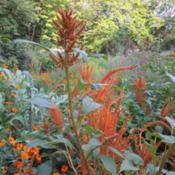 |
Amaranth (Amaranthus cruentus 'Hot Biscuits') |
Have |
Sow Indoors: Feb 10 DTG: 7 – 14 Days Seed Depth: ¼" Transplant: April 10 Maturity: 65 - 75 days Ht. 48–60" Annual. A dual-purpose crop, both nutritious and decorative. From the Greek amarantos for 'unfading.' Used as an ornamental, especially in harvest arrangements. Amaranth was an extremely important food of the Aztecs. ~1,250 seeds/g. https://fedcoseeds.com/seeds/h... |
April 9, 2023: Transplanted |
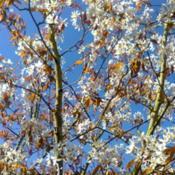 |
Juneberry (Amelanchier lamarckii) |
Want |
||
 |
Winged Everlasting (Ammobium alatum) |
Prev |
Sow indoors in March - April, or outdoors in poor, well-drained soil in full sun after last frost https://www.youtube.com/watch?... Soil Type: Well-drained, pH 5.5 to 6.5 Temperature: 60 - 68F Average Germ Time: 4 - 7 days Light Required: Yes The winged everlasting Daisy often grows in disturbed environments such as on roadsides and agricultural land, and sometimes on riverbanks where the seeds have been carried from disturbed areas. Records of this species in natural habitats are from eucalypt forests in plateau and rocky cliffs in northern New South Wales, from river banks in the upper Snowy River in Victoria, from the Northern Tablelands and North West Slopes of New South Wales and from south-east Queensland. Robert Brown found it "growing plentifully near the shores of Port Hunter (or the Coal River) in New South Wales" in 1804. The species is naturalized in South Australia, The Australian Capital Territory and Tasmania, and in places outside its natural distribution in New South Wales. The genus Ammobium and Ammobium alatum were first described in 1824 Robert Brown in Curtis Botanical Magazine. The name Ammobium is from the Greek words, ammos ("sand") and bios (" life"), describing the genus as growing in sand,[6][7] and the specific epithet alatum is from the Latin alatus meaning "winged"[8] in reference to its winged stems. Used in dried floral arrangements. Cut when flowers open about half way, typically in mid-summer, tie and hang up-side-down in warm, well-ventilated space. |
April 15, 2023: Seeds sown |
 |
Blue Star (Amsonia 'String Theory') |
Have |
April 17, 2023: Transplanted | |
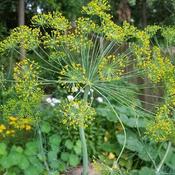 |
Dill (Anethum graveolens 'Bouquet') |
Have Herb Garden Medicinal Herb Culinary Herb |
https://www.youtube.com/watch?... Direct sow late spring through summer, or sow when cucumbers are transplanted, to coincide maturity for pickling. Dill tends to bolt if transplanted, so it is best direct sown. Stagger the harvest by sowing every 2-3 weeks for a constant supply of fresh leaves. Temperature for germination: 15-21°C (60-70°F). DTG: 10-21 days. Needs light to germinate. Sow 5mm (¼") deep. Thin the plants to 15cm (6″) apart. Grow in moderately rich soil in full sun. Water and feed regularly, and stop any overhead watering once plants are 60cm (24″) tall to prevent issues with mildew forming on the leaves. Harvest Begin harvesting once plants reach 15cm (6″) tall. About 12 weeks after sprouting the seed heads begin to form. When the first seeds have turned brown, cut the whole head and hang it upside down for the drying seeds to fall out into trays or paper bags. Dill leaf loses most of its flavor when dried, so freeze it in ice cube trays filled with water for use all winter. Companion Planting Dill improves the health of cabbages and other Brassicas, and is a very good companion for corn, cucumbers, lettuce, and onions. Dill attracts ladybugs, lacewings, and the parasitoid wasps that feed on garden caterpillars. At the same time it repels aphids and spider mites. Avoid planting near carrots and tomatoes. - https://www.westcoastseeds.com... |
March 27, 2021: Obtained plant March 6, 2022: Obtained plant March 25, 2023: Transplanted (HD) |
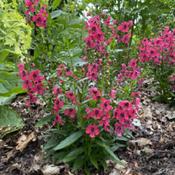 |
Summer Snapdragon (Angelonia angustifolia Archangel™ Cherry Red) |
Prev Annual Garden |
||
 |
Summer Snapdragon (Angelonia angustifolia Archangel™ Coral) |
Prev |
https://www.ballseed.com/Plant... | May 1, 2021: Obtained plant |
 |
Summer Snapdragon (Angelonia angustifolia Archangel™ Pink) |
Prev |
November 8, 2020: Winterized |